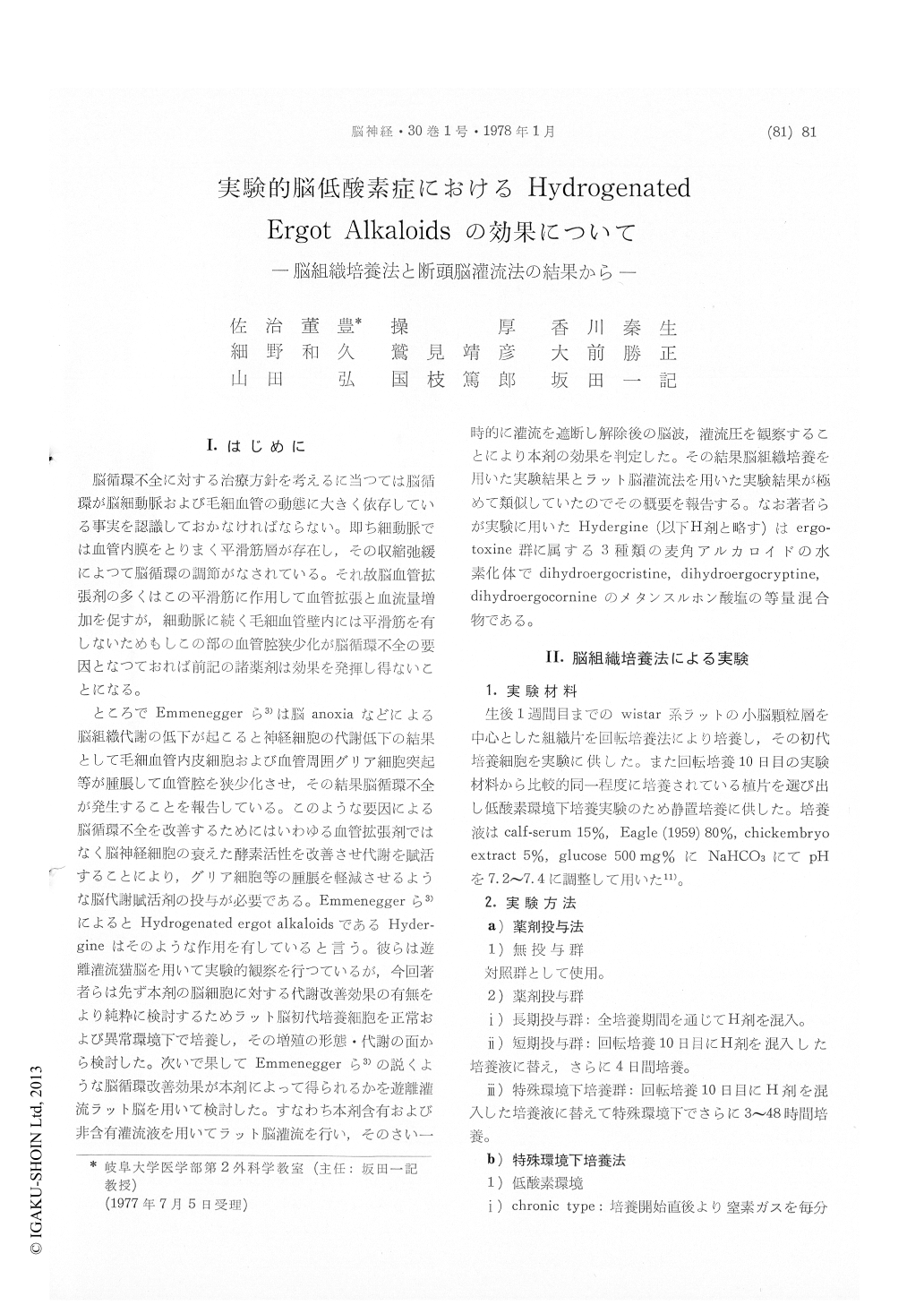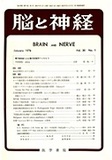Japanese
English
- 有料閲覧
- Abstract 文献概要
- 1ページ目 Look Inside
I.はじめに
脳循環不全に対する治療方針を考えるに当つては脳循環が脳細動脈および毛細血管の動態に大きく依存している事実を認識しておかなければならない。即ち細動脈では血管内膜をとりまく平滑筋層が存在し,その収縮弛緩によつて脳循環の調節がなされている。それ故脳血管拡張剤の多くはこの平滑筋に作川して血管拡張と血流量増加を促すが,細動脈に続く毛細血管壁内には平滑筋を有しないためもしこの部の血管腔狭少化が脳循環不全の要因となつておれば前記の諸薬剤は効果を発揮し得ないことになる。
ところでEmmeneggerら3)は脳anoxiaなどによる脳組織代謝の低下が起こると神経細胞の代謝低下の結果として毛細血管内皮細胞および血管周囲グリア細胞突起等が腫脹して血管腔を狭少化させ,その結果脳循環不全が発生することを報告している。このような要因による脳循環不全を改善するためにはいわゆる血管拡張剤ではなく脳神経細胞の衰えた酵素活性を改善させ代謝を賦活することにより,グリア細胞等の腫脹を軽減させるような脳代謝賦活剤の投与が必要である。Emmeneggerら3)によるとHydrogcnated ergot alkaloidsであるHyder—gineはそのような作用を有していると言う。
The first part of the present investigation was performed to examine effect of dihydroergot alkaloid (Hydergine) on cultured rat's cerebellar cells. Hydergine was applied to the culturing medium according either to a long term schedule or to a short term schedule. Effects of the drug on migration rate and morphology of the cells were observed. Furthermore, effects on cultured cells of anoxic and low glucose circumstances were observed. H3-uridine uptake by cultured cells as revealed by radioautographic method, also was observed for the purpose of getting information on cultured brain cell metabolism. Results were as follows.
1) In the normal oxygen and glucose circum-stance, addition of Hydergine to the medium in-duced no change in cell migration rate as well as in cell morphology as compared with those of control experiments.
2) Without Hydergine, almost all of the cultured cells were found to die and disappear within 10 hours in the acute type anoxia (PO2 10-15mmHg) and within 24 hours in the chronic type anoxia (PO2 60mmHg) respectively. However, when 10 μg/ml of Hydergine was added to the medium, only a few degenerated and dead cells were dis-cernible in the same period.
3) In a low glucose (15-20mg%) medium, without Hydergine, the cultured cells were still remaining alive after 10 hours of incubation. However, when 10μg/ml of Hydergine was added to the medium, almost all of the cultured cells were found to die and disappear in the same period.
4) Intracellular uptake of H3-uridine was sparse in anoxic state. Howeber, when 10 /tg/ml of Hydergine was added to the medium, the uptake was definitely increased up to nearly normal level.
These results indicated that Hydergine acted directly on the brain cells and stimulated anaerobic glycolysis in the circumstance of hypoxia, resulting in maintenance of brain metabolism.
The second part of the present investigation was performed to examine effect of Hydergine on cere-bral circulation by isolated rat's brain perfusion method. Hydergine was given in to the perfusing solution, consisting of fluorocarbon emulsion. Effects of the drug on recovery of EEG and on change of perfusion pressure after release of tempo-rary interruption of cerebral blood flow were ex-amined. Results were as follows.
Without Hydergine recovery of EEG was not noted and perfusion pressure was higher than the control immediately after release of 5 minutes' interruption of cerebral blood flow. However, when 18μg/minute of Hydergine was added to the perfusing solution, recovery of EEG was noted and perfusion pressure was lower than the control immediately after release of 5 minutes' inter-ruption.
On the bases of these results, Hydergine is con-sidered to be effective for maintaining brain metabolism under hypoxia and for improving cere-bral vascular insufficiency by maintaining brain metabolism in anoxic states during interruption of cerebral blood flow.

Copyright © 1978, Igaku-Shoin Ltd. All rights reserved.


